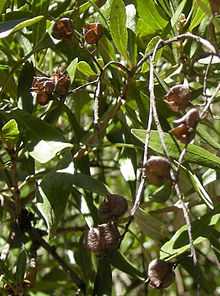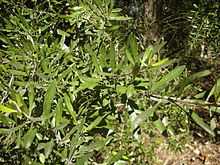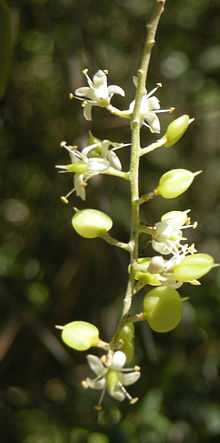Bursaria spinosa
| Bursaria spinosa | |
|---|---|
 | |
| Scientific classification | |
| Kingdom: | Plantae |
| (unranked): | Angiosperms |
| (unranked): | Eudicots |
| (unranked): | Asterids |
| Order: | Apiales |
| Family: | Pittosporaceae |
| Genus: | Bursaria |
| Species: | B. spinosa |
| Binomial name | |
| Bursaria spinosa Cav. | |
| Synonyms | |
|
Itea spinosa Andrews | |
Bursaria spinosa is a small tree or shrub in the family Pittosporaceae. The species occurs in mainly in the eastern and southern half of Australia and not in Western Australia and the Northern Territory. Reaching 10 m (35 ft) high, it bears fragrant white flowers at any time of year but particularly summer. A common understory shrub of eucalyptus woodland, it aggressively colonises disturbed areas and fallow farmland. It is an important food plant for several species of butterflies and moths, particularly those of the genus Paralucia.
Taxonomy
First collected in the vicinity of Port Jackson, Bursaria spinosa was first described by Antonio José Cavanilles in 1797. It is known by many common names, including Australian blackthorn, Blackthorn, Christmas bush, mock orange, native blackthorn, native box, native olive, prickly box, prickly pine, spiny box, spiny bursaria, sweet bursaria, thorn box and whitethorn.[1] Summer flowering has given rise to the name (Tasmanian) Christmas bush in Tasmania and South Australia (not to be confused with Prostanthera lasianthos).[2] Indigenous names recorded include kurwan in Coranderrk, Victoria, and geapga from Lake Hindmarsh Station.[3]
Bursaria spinosa is highly variable in appearance and habit, as are other species within the genus, and there have been several attempts at classification since their discovery. The Austrian botanist Aloys Putterlick divided Bursaria spinosa into spiny (spinosa) and lacking spines (inermis) in 1839. Several subspecies have been described, but a 1999 revision of the genus recognises only two, one of which B. spinosa lasiophylla had been considered a separate species.[3]
Thus subspecies spinosa is a 5–10 m shrub or tree found widely across eastern Australia and Tasmania from the Eyre Peninsula, Flinders Ranges and Kangaroo Island in South Australia to north Queensland. Subspecies lasiophylla has shorter, wider leaves and smaller flowers and only reaches 5 m. It replaces the other subspecies on heavier clay soils in southeastern Australia (eastern South Australia and southern New South Wales).[3]
Description

Bursaria spinosa has a variable habit, and can grow anywhere from 1 to 12 m high.[4] The dark grey bark is furrowed.[3] The smooth branches are sometimes armed with thorns, and the leaves are arranged alternately along the stems or clustered around the nodes and have a pine-like fragrance when bruised. Linear to oval or wedge-shaped (ovate, obovate or cuneate), they are 2–4.3 cm long and 0.3–1.2 cm wide with a rounded apex. The fragrant flowers can occur at any time of year, but mainly appear in the summer.[5] They are arranged in leafy pyramid-shaped panicles.[3]
Distribution and habitat
In the Sydney region, it grows on clay- and shale-based soils, as an understory plant in association with grey box (Eucalyptus moluccana) and forest red gum (E. tereticornis) as well as the grass Themeda australis. It can form thickets on farmland which is ungrazed.[3][6] In Tasmania, it grows extensively on rocky hills with shallow soils, amid open eucalypt forests and grassland on the islands east coast and Midlands regions. In the Southern Midlands and around Hobart, it grows extensively on open slopes where it forms large stands of stunted shrubs amidst grazing land.
Ecology

Living for 25 to 60 years, Bursaria spinosa can resprout from its woody base after bushfire.[6] Highly rhizomatous, plants of a stand are often genetically a single plant. Despite being genetically identical, different plants and even single shoots can be very distinct in appearance (for instance, spineless shoots previously regarded as a subspecies "inermis").[3] Its seed is wind-dispersed and it is a colonising plant.[6]
A wide variety of insects visit the flowers of Bursaria spinosa, the most important pollinators of which appear to be beetles of several families. Common visitors recorded from field work around Armidale were jewel beetle species such as Curis splendens and Stigmodera inflata, longicorn beetles including Amphirhoe sloanei and Tropocalymma dimidiatum, scarab beetles and tumbling flower beetles. Beetles and scoliid wasps all carried significant amounts of pollen. Other visitors such as flies and butterflies carried much lower amounts.[7] The larvae of the jewel beetle species Astraeus crassus live in tunnels in dead and dying branches. Caterpillars which feed on Bursaria spinosa include Proselena annosana, two-ribbed arctiid (Palaeosia bicosta) and bark looper moth (Ectropis subtinctaria), while those of the clouded footman (Anestia ombrophanes) graze on algae and lichens which grow on the branches.[6]
The Bright Copper (Paralucia aurifera) and ant species Anonychomyrma nitidiceps form a complex symbiotic relationship on Bursaria spinosa. Butterflies lay their eggs on the underside of the leaves, and the caterpillars feed on the leaves before pupating in the soil at the foot of the plant. The ants excavate chambers in the soil where the caterpillars sleep and later pupate, and accompany the caterpillars when the latter are feeding. They are thought to feed on the caterpillars' secretions.[8] Caterpillars of the Fiery Copper (Paralucia pyrodiscus) are likewise accompanied by ants of the genus Notoncus,[6] and the third species, the endangered Bathurst Copper (Paralucia spinifera), also breeds and feeds exclusively on the subspecies lasiophylla in Central New South Wales.[9]
Cattle and rabbits graze on young plants.[6]
Uses
The drug aesculin is harvested from the plant in the Sydney region.[10] Although its thorns make it unpopular in cultivation, Bursaria spinosa provides nectar for butterflies and a safe haven for small birds.[2]
References
| Wikimedia Commons has media related to Bursaria spinosa. |
- ↑ "Bursaria spinosa Cav.". Australian Plant Name Index (APNI), IBIS database. Centre for Plant Biodiversity Research, Australian Government.
- ↑ 2.0 2.1 Walters, Brian (November 2007). "Bursaria spinosa". Australian Native Plants Society. Retrieved 17 September 2011.
- ↑ 3.0 3.1 3.2 3.3 3.4 3.5 3.6 Cayzer, L. W.; Crisp, M. D.; Telford, I. R. H. (1999). "Bursaria (Pittosporaceae): A morphometric analysis and revision". Australian Systematic Botany 12: 117–43. doi:10.1071/SB97036.
- ↑ "Bursaria spinosa". Electronic Flora of South Australia Fact Sheet. State Herbarium of South Australia.
- ↑ New South Wales Flora Online: Bursaria spinosa by B.J. Conn & R.G. Coveny, Royal Botanic Gardens & Domain Trust, Sydney, Australia.
- ↑ 6.0 6.1 6.2 6.3 6.4 6.5 Benson, Doug; McDougall, Lyn (1999). "Ecology of Sydney plant species: Part7a Dicotyledon families Nyctaginaceae to Primulaceae". Cunninghamia 6 (2): 402–509.
- ↑ Hawkeswood, Trevor J. "Insect pollination of Bursaria spinosa (Pittosporaceae) in the Armidale area, New South Wales, Australia". Giornale Italiano Di Entomologia 5: 67–87.
- ↑ Cushman, J. Hall ; Rashbrook, Vanessa K.; Beattie, Andrew J. (1994). "Assessing Benefits to Both Participants in a Lycaenid-Ant Association". Ecology 75 (4): 1031–41. JSTOR 1939427.
- ↑ Threatened Species Unit Conservation Programs and Planning Division, Central Directorate NSW NPWS (June 2001). "Bathurst Copper Butterfly". Hurstville, New South Wales: NSW National Parks and Wildlife Service. Retrieved 19 September 2011.
- ↑ Smith, R. (1993). "The commercial use of Bursaria spinosa". Society for Growing Australian Plants Queensland Region Bulletin: 9–13.